- Contemporary
- International Affairs
- Law & Policy
- Civil Rights & Race
- History
When I first started working in the Hoover Archives in 1978, George Duca, a European gentleman in his seventies, came to the reading room of the Hoover archives every morning promptly at 7:45, impatient to get to work. He spoke both English and French with a slight Eastern European accent. I discovered that he had donated the memoirs of his father, Ion Duca, the prime minister of Romania who had been assassinated by the fascist Iron Guard in 1933. In the years between the two world wars, when a small educated elite was struggling to establish stable nation-states in Eastern Europe, the loss of a leader of Ion Duca’s stature was devastating. His assassination was part of a tragic chain of events that plunged Romania first into fascism and then communism. His son was motivated by both personal and historical obligations to keep the memory of prewar Romanian culture alive.
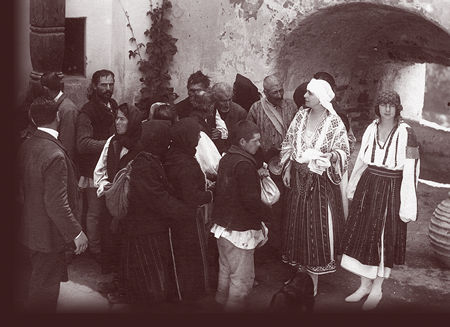 |
|
In a photo from the 1920s, the charismatic Queen Marie (with white head scarf) and her daughter, Princess Ileana, meet with Romanian peasants. |
At the archives, George kept up a voluminous correspondence with fellow émigrés scattered throughout Europe and the United States. Next to his typewriter he kept an autographed photo of an elegantly coifed and draped woman wearing phenomenal pearls. “She was my mentor,” George explained, “Queen Marie of Romania.” Although Marie died in 1938, George talked of her frequently. He also maintained a correspondence with Marie’s youngest daughter, an orthodox abbess named Mother Alexandra (originally called Princess Ileana).
Remnants of a Lost World
George Duca encouraged his network of Romanian émigrés to deposit materials from Romania’s past with the Hoover Archives, where they could be preserved and made available to scholars. In response, boxes began arriving from New York, Paris, and London filled with the remnants of a lost world. Photographs revealed the flamboyant lifestyle of the Romanian royal family. Marie, whose paternal grandmother was Queen Victoria and whose maternal grandfather was Tsar Alexander II of Russia, reveled in her role as monarch and enjoyed great popularity in her adopted country. She dressed the part and designed furnishings for the family castles in a romantic, Byzantine revival style. The documents show a more serious side of her nature: her work to keep Romania on the Allied side in World War I (despite the German sympathies of her Hohenzollern husband, King Ferdinand), her negotiations to hold the Allies to their commitments during the Paris Peace Conference following the war, her futile efforts to prepare her son Carol II for the throne, and the hopes she placed in her bright and thoughtful grandson Michael.
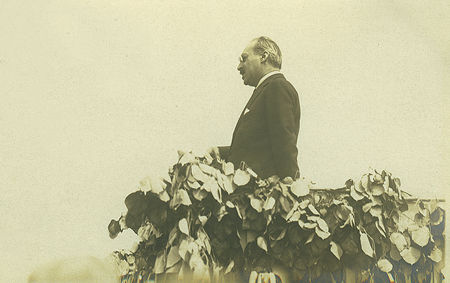 |
|
Foreign Minister Ion Duca addresses a crowd from a platform decorated with foliage during a patriotic celebration in 1925. Duca became prime minister in 1933. |
George Duca, who had served in the Romanian diplomatic corps, garnered boxes of papers from Romanian ambassadors, politicians, and government officials, such as George Caranfil, Brutus Coste, and Alexandru Cretzianu. Duca also collected evidence of the brutality of the communist system in Romania and the fate of religious and political leaders exterminated in the Romanian Gulag.
From Bucharest to Stanford
Duca’s loyalty to the archives was based on the Hoover Institution’s commitment to compiling an objective documentary history of Eastern Europe. The first collecting by Hoover curators, such as E. D. Adams and Herbert Hoover himself, began at the Paris Peace Conference in 1919. Although Hoover was skeptical of the colorful Queen Marie and her role in the negotiations, he was determined to support the growth of democratic institutions in Romania. Frank Golder, another Hoover collector, was sent to Bucharest in 1921, where he established a working relationship with the prominent Romanian historian and politician Nicolae Iorga and won his support for an acquisition program (Iorga would be assassinated by fascists in 1940). Thanks to Golder and Iorga, the Hoover Institution has preserved rare copies of Romanian newspapers from the World War I era, the only copies in the United States. That systematic collecting program was maintained until 1947 and resumed in the 1960s.
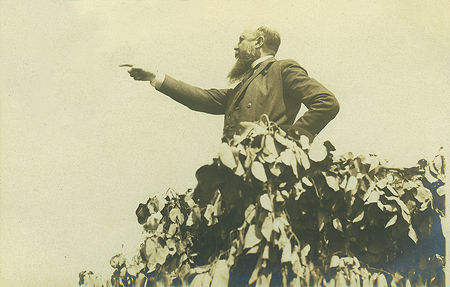 |
|
The historian Nicolae Iorga (1871–1940) is seen here in his role as a politician delivering a speech. He served as prime minister in 1932. Later he would publish a definitive 11-volume history of the Romanians. |
After the Communists took control in Romania, most material in the Romanian collection came from émigré sources. The collection includes approximately 15,000 monographs, 70 journals, 60 newspapers, and 70 archival collections. George Duca deposited his father’s memoirs in the Hoover Archives in 1966. The diaries and papers of Romanian diplomat Nicolae Titulescu arrived in 1974. George Duca brought his own diaries to Hoover in 1975.
When not collecting fragments of Romania’s past for the archives, Duca edited his father’s handwritten memoirs for publication by an émigré press. He then edited his own three-volume chronicle of Romanian history in the twentieth century, based in part on his more than 120 diaries. For 10 years, until his death in 1985, Duca attracted a steady stream of visitors to the Hoover Institution, including many historians from the most Stalinist of East European regimes, all of whom would have been under enormous pressure to collaborate with the notorious security services.
Duca, although cautious, helped scholars from Romania document such dramatic events as the August 1944 negotiations that switched Romania to the Allied side in World War II. To accomplish this feat, King Michael of Romania, only 23 at the time, had to overthrow the powerful dictator Marshal Ion Antonescu. Duca himself, as a young diplomat in neutral Sweden, participated in forging the new ties with the Allies. Duca remained steadfastly loyal to Michael and always referred to him as “my king.”
Despite numerous invitations, Duca resolutely refused to visit Romania under the communist regime. He died before the December 1989 overthrow of the communist dictator Nicolae Ceausescu.
After the Fall
The Hoover Institution’s network of East European specialists documented the fall of communism as it happened, collecting artifacts from the upheaval, such as copies of Romania’s first free newspaper, Libertatea, and a Romanian flag with the communist hammer and sickle torn from the center. The archives staff assembled photos of the street riots and scenes of hardship and displayed them in a series of exhibitions in the Hoover Exhibit Pavilion. The curators collected posters from the first tumultuous election campaigns with images of leaders such as Petre Roman, Ion Iliescu, and the returned émigré Ion Ratiu. In the 1996 elections Emil Constantinescu, rector of Bucharest University, decided to enter the political fray and won the presidency.
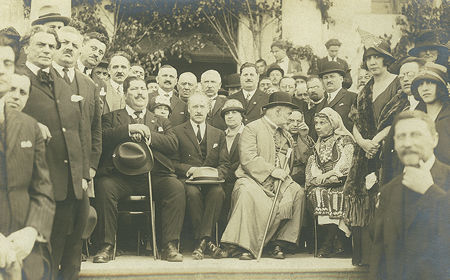 |
|
Ion Duca, seated in the center, attends the May 15, 1925, commemoration of the Great National Assembly of 1848, which met in the city of Blaj during the revolutionary year of 1848. The events in Blaj served as inspiration for the movement for the unification and independence of Romania. |
The documents coming to the archives from Romania in the 1990s present a mixed picture of progress and hardship. In May 2000, Laura Cosovanu, a Romanian specialist, and I traveled to Bucharest to observe a society undergoing fundamental transformation. I experienced firsthand the lavish Romanian hospitality one reads about in travel accounts, as well as spirited intellectual debate. The politicians and intellectuals we interviewed disagreed with each other on many issues. Everyone we spoke with, however, regardless of political affiliation, agreed that Romania’s main goals must be to achieve membership in NATO and the European Union. To this end, work is being undertaken to make the Romanian legal system more compatible with that of Western Europe, to combat the rise in Mafia-style lawlessness, and to build civil institutions.
Addressing the Past
I was particularly interested in how Romania was coming to terms with its difficult history. To this day, the history of the communist rise to power between 1944 and 1947 is muddled and incomplete, as is the chain of events that brought the Communists down in December 1989. Some influential public figures have taken on the task of compiling an accurate history. One of the most prominent is Ana Blandiana, a courageous dissident poet and one of the few who stood up to the old regime, who now heads a foundation and museum project. Her organization, the Civic Academic Foundation, has conducted thousands of hours of interviews with former political prisoners and is entering them into a sophisticated database that permits extensive statistical analysis and enables people to learn the fate of family members. Blandiana has renovated Sighet, a notorious political prison where the Romanian intelligentsia were imprisoned (and many perished), into the Museum of the Victims of Communism and Anti-Communist Resistance, which is also a research and conference center. Blandiana’s organization hosts seminars and publishes a newsletter in both Romanian and English.
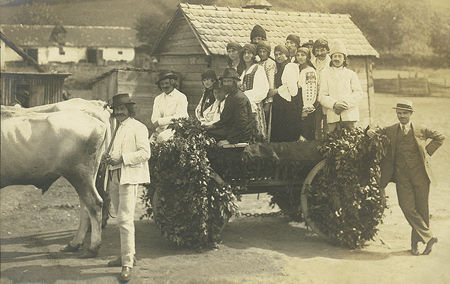 |
|
Peasants in traditional dress celebrate national heroes from the long struggle for independence. |
We met with Andrei Plesu, rector of the New Europe College, who is also attempting to address Romania’s past. During the 1980s, anyone who met with the dissident Plesu was likely to be harassed by the state security police (the Securitate). Following the fall of communism, he has held a series of official posts, such as minister of culture and minister of foreign affairs. Ironically, Plesu, himself once a target of the Securitate, is now a member of the council considering how to handle the information contained in the files of the former security services. When asked about the most meaningful way to preserve an understanding of the dramatic events of modern Romania, Plesu argued for the establishment of public archives, citing the Hoover Archives as a model.
Foreign Minister Petre Roman, who also agreed to an interview with us, was in the crowd in December 1989 when the security forces opened fire, and his courage during the violence launched his career in the new electoral politics. During our talk he stressed building ties with NATO and the European Union as a way to rebuild democratic institutions. His offices are lined with oil portraits of the precommunist foreign ministers, including Ion Duca.
On May 19, 2000, President Emil Constantinescu cordially received us for a private interview in the ornate Cotroceni Palace, once the home of King Ferdinand and Queen Marie. Constantinescu discussed the importance of the different East European countries’ experiences in the transformation of the past few years. Even participants, he explained, were too caught up in the turmoil to have a clear overview of the events in Eastern Europe. Concerned that the achievements of the last 10 years would slip away, he expressed hope that the first generation of anticommunist leaders of Eastern Europe, the ones who brought down the communist regime, would form a council to advise on solidifying democratic institutions in the region.
History vindicated George Duca and the other Romanian émigrés who had unequivocally denounced the communist regime. From interviews with the new leadership, it is clear that Romania’s struggle to establish a Western-style democracy has just begun and that the mission of the Hoover Archives to document Romania’s long struggle has entered a new phase.







